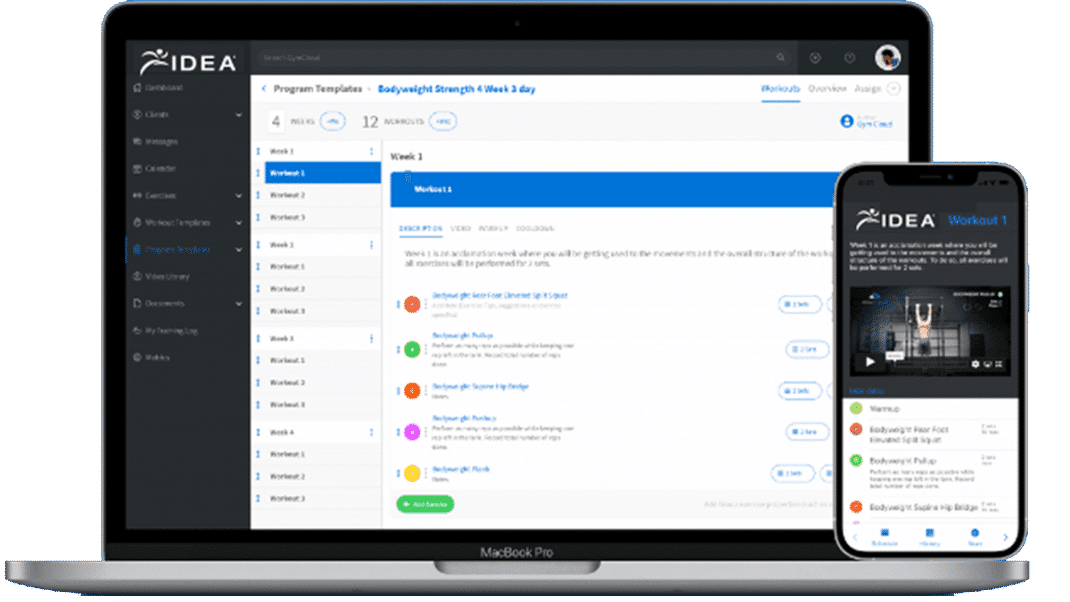Fitness E-Books
Ready to publish a book? Consider the benefits of launching an e-book.
Fitness professionals who publish their own works can gain an extra reputation boost and, in turn, see significant business increases. From traditional printed publications (journals and books) to the digital press (blogs and e-zines), what format you publish has come to be as important as what you publish. The newest format to see a significant increase in popularity is electronic books, or e-books. E-books combine the best of both the printed world and the digital world.
In one 3-month period in 2010, Amazon.com sold more e-books than hardcover books and also tripled its sales of the Kindle™ (the company’s e-reader device). With the growing popularity of other e-readers, such as Apple’s iPad and Barnes & Noble’s Nook™, e-book sales are expected to continue to rise (Fowler & Trachtenberg 2010).
Fitness professionals looking to package their ideas into a book might want to consider e-books as a way to reach consumers. Read on to learn the advantages of publishing in the e-book format and what it takes to produce and market your e-book successfully.
The Electronic Advantage
Along with books and blogs, e-books are an effective medium for delivering content to targeted readers. E-books are digital publications delivered via download, combining the structure of a book with the dynamic capabilities of a blog post.
Like traditional books, e-books are portable and can be read offline (although a wireless connection is needed for downloads). While e-books are most often read on digital screens (such as e-readers or other mobile devices), readers can choose to print all or some of a book on paper. Because e-books are distributed digitally, there are no direct costs associated with the publishing, shipping or retailing. Needless to say, this makes e-books economically (and environmentally) friendly!
Much like information delivered via blogs and websites, e-books include rich media (such as hyperlinks and audio and video content) and are not restricted in their number of pages or words. While some e-books may contain a table of contents, e-readers include search functions and annotation tools to make the content easier for the reader to navigate. Unlike Web-based media, e-books do not overwhelm readers with digital “bling” (such as sidebar widgets, social media buttons and ads).
Producing an E-Book
Any fitness pro with a word processing application and a file converter (such as Adobe® PDF) can create an e-book. When it comes to distribution, the approach can be as simple as e-mailing the book (file) to a client or as coordinated as having a dedicated website from which all marketing and sales are managed. But before you launch your e-book into the digital arena, there are a few steps to consider.
Protect Your Property
Digital media is easily transferable. Unless you intend to “go viral” with your product, you need to take steps to prevent illegal file-sharing in order to avoid loss of revenue. There are nearly a dozen different formats for your e-book, depending on its compatible platform (i.e., Kindle or iPad), but the ones that are most widely used are .pdf (portable document file), the more secure .exe (executable file) and the most common .ePub (electronic publication). Compiler software, such as Adobe Digital Editions, can generate most of these conversions. Please note that webstores like Amazon or Apple’s iBookstore may accept e-book submissions from authors in these forms, but they will convert the content and deliver it in their own format.
Price Your Product
An e-book can be positioned as a stand-alone product. Or it can be offered at no cost—for example, as a “white paper,” an authoritative report or guide addressing an industry issue—as part of a greater business or marketing strategy. But if you plan on selling your e-book, setting the right price is crucial. Among consumers, the general perception is that e-books should have a lower asking price simply because they have low (or no) production costs. However, your expertise is what is for sale, regardless of the format. E-books can cost anywhere from 99 cents to hundreds of dollars. Before settling on a price, research the competing books on your topic (in both printed format and electronic format).
Create an Attractive Presentation
Since an e-book is digital, any attempt to make it look and feel like a real book is helpful. Create a visual 3-D cover (icon) of your book and dedicate a specific Web page or domain URL where potential buyers can go for further information. If you do not have graphic design skills, do a keyword search for “e-book cover” and you will discover freeware designed specifically for this task.
Offer Purchase Options
If you are offering the e-book for free, always ask for a reader’s e-mail address in exchange for the download. Having this information will help you build your network of contacts and generate leads. If your book will be for sale, use third-party merchant accounts (like PayPal™) to act as the intermediary between purchase and download. Listing your e-book with popular sites like Amazon or iBookstore is effective in increasing sales, but be aware that these sites keep a large percentage of all sales.
The E-Book Audience
Before publishing your e-book, compare your target audience with the audiences that are most likely to download e-books. Consider this: only 4% of Americans own e-book readers (such as Kindle and iPad); of these, 8% have an income greater than $75,000 and 9% are college graduates (Pew Internet 2010).
But e-books are not just for those who want to read them on mobile platforms. Many consumers still download e-books from the Web and save them as files on their desktop to read or reference later. Libraries are increasing their e-book database, and academic institutions are starting to offer more digital resources to students (Kolowich 2010). Digital bookstores like Ebooks.com and specialty sites like Fitness-Ebooks.com are also supplying a large variety of industry-specific e-books for iPhones, iPads, PCs, Macs, Sony® Readers and mobile phones.
More people are growing comfortable reading books electronically. Although e-books may never fully replace the printed word (some people argue differently), fitness professionals will find that e-books provide immediate access to publishing options and greater opportunities for increasing revenue and reaching target markets.
Biray Alsac, MS, is a fitness technologist, studying the various implications that exergames and social media have in the fitness industry. Follow her on Twitter (@befitt) or check out www.BeFitWithBiray.com to download her e-book on fitness podcasting.
The market for fitness e-books is no more or less saturated than the market for blogs, but the following tips can help distinguish your e-book from others.
- Offer E-Books in Multiple Formats. Make sure your e-book is available on top consumer platforms (Kindles and iPads). If appropriate, consider creating an audio version of your e-book. While it may seem counterintuitive to sell an e-book in printed form, a large audience still prefers reading a paper book. Online self-publishing sites like Lulu.com and CafePress.com offer options for consumers who want to print-on-demand (printing books as they are purchased).
- Create a Buzz Before You Publish. Prior to its official launch, hype your e-book through press interviews, online social media networks and offline conversations with colleagues. If appropriate, offer a few chapters of the book for free as a teaser.
- Market Your E-Book Using Niche Online Social Networking Sites. Including LinkedIn and Facebook marketing is smart. So is promoting your efforts in niche sites like Shelfari.com and LibraryThing.com, where the network focus is centered on books. Build reading groups exclusively for your e-book, and meet other readers based on their interest in fitness and wellness-related topics.
- Enlist the Help of a Professional Writer or Editor. Before you send your e-book as a final edition, spend the extra money to have your work corrected by a professional editor. This makes your writing sound polished while staying true to your original voice.
- Have Your Foreword Written by an Industry Expert. Two (or even three) names on an e-book sell better than one. A foreword can act as the stamp of approval on your e-book and showcase the strengths of your network. And if your colleagues use social media, you can also leverage their networks in the promotion of your e-book!
- Launch an Online–Offline E-Book Tour. Create opportunities to talk about your e-book by being a featured guest on blogs and podcasts and by hosting specialty webinars around your topic. This pushes traffic to your e-book’s website and increases the chance of purchase or download. And do not limit your tour to online environments; schedule a real-life speaking engagement at a bookstore or a fitness event. Now that Amazon, Apple’s iBook and Barnes & Noble have their own bookstore mobile apps, take advantage of the fact that consumers can download your book on the spot!
References
Fowler, G.A., & Trachtenberg, J.A. 2010. Amazon says e-book sales outpace hardcovers. Wall Street Journal. http://online.wsj.com/article/NA_WSJ_PUB:SB10001424052748703720504575377472723652734.html; retrieved Sept. 6, 2010.
Kolowich, S. 2010. All in the delivery. Inside Higher Ed. www.insidehighered.com/news/2010/08/31/ebooks; retrieved Sept. 29, 2010.
Pew Internet. 2010. Mobile access using laptops and other devices. www.pewinternet.org/Reports/2010/Mobile-Access-2010/Part-3.aspx?r=1; retrieved Sept. 6, 2010.
Biray Alsac, MS
Biray Alsac, MS, is the owner of FITTmaxx Institute, a consulting company for health organizations and fitness/wellness professionals interested in learning how to integrate Web-based tools and interactive technologies (exergames) into their programming. She holds a masterÔÇÖs degree in exercise and wellness. Certification: ACE Education provider for: ACE






